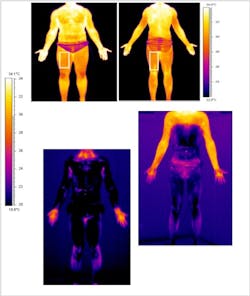Thermal imaging improves sports medicine and exercise research
Described in the Journal of Thermal Biology, the Department of Sport and Exercise Science at the University of Portsmouth in England is using FLIR Systems (Wilsonville, OR) thermal imaging cameras for measuring skin temperature at rest, during exercise, and recovery.
RELATED ARTICLE: FLIR thermal imaging cameras aid bat research and conservation
Skin temperature is an important physiological measurement that can reflect the presence of illness and injury as well as provide insight into the localized interactions between the body and the environment. Historically, human skin temperature has been assessed using contact measurement devices including thermocouples and skin thermistors that have limitations.
Joe Costello, a senior lecturer in exercise physiology said, "I have used FLIR Systems thermal cameras in Australia, Ireland and the UK as my measurement technology of choice to assess human skin temperature. My research group is currently using FLIR thermal imaging cameras to examine the effects of different stress factors including temperature, hypoxia, clothing and exercise on human skin temperature."
Costello added, "The greatest advantage of thermal imaging over traditional methods of assessing skin temperature is the fact that it is non-invasive and portable. Thermal imaging does not have to be in contact with the skin, an obvious advantage for measurement, especially in a clinical context. Contact devices such as skin thermistors and thermocouples often consist of a thin metallic foil which serves as a heat spreader backed by a foam insulation pad. This has the potential of creating a layer of insulation over the area of skin being assessed and therefore significantly degrades the accuracy of the measured temperature. This artefact of testing, recording, and reporting erroneous skin temperature data is therefore troublesome. Another advantage that our FLIR thermal cameras offer over thermistors is the wealth of data that they can collect. Using our FLIR cameras, temperature variation over large areas of skin can be quantified quickly and accurately."
SOURCE: FLIR Systems; http://www.flir.co.uk/science/content/?id=67274

Gail Overton | Senior Editor (2004-2020)
Gail has more than 30 years of engineering, marketing, product management, and editorial experience in the photonics and optical communications industry. Before joining the staff at Laser Focus World in 2004, she held many product management and product marketing roles in the fiber-optics industry, most notably at Hughes (El Segundo, CA), GTE Labs (Waltham, MA), Corning (Corning, NY), Photon Kinetics (Beaverton, OR), and Newport Corporation (Irvine, CA). During her marketing career, Gail published articles in WDM Solutions and Sensors magazine and traveled internationally to conduct product and sales training. Gail received her BS degree in physics, with an emphasis in optics, from San Diego State University in San Diego, CA in May 1986.
